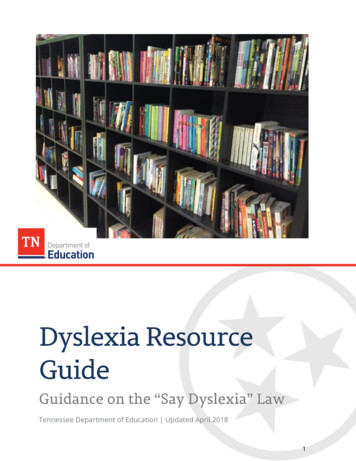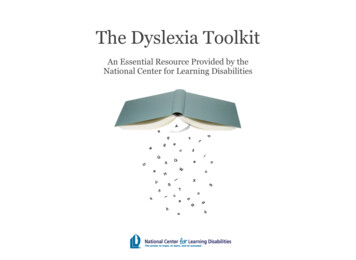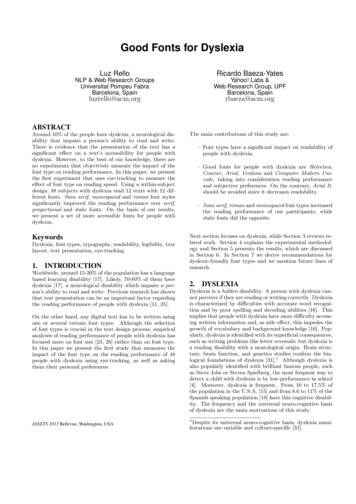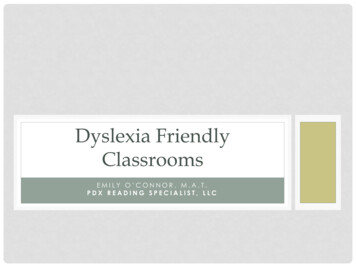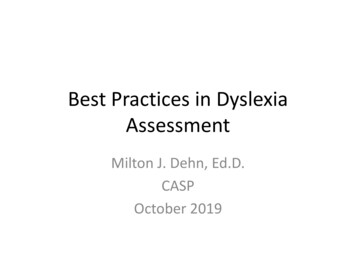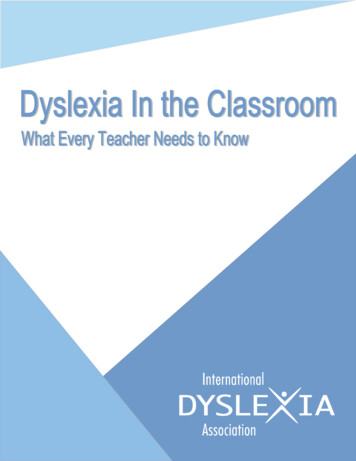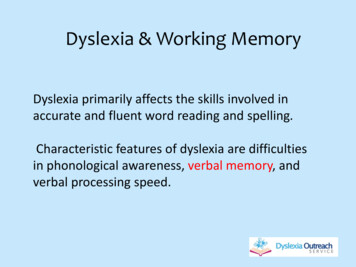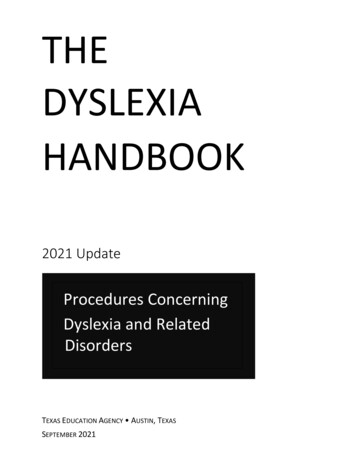
Transcription
THEDYSLEXIAHANDBOOK2021 UpdateProcedures ConcerningDyslexia and RelatedDisordersTEXAS EDUCATION AGENCY AUSTIN, TEXASSEPTEMBER 2021
THE DYSLEXIA HANDBOOKProcedures Concerning Dyslexia and Related Disorders2021 Update 2021 by the Texas Education AgencyCopyright Notice.The Materials are copyrighted and trademarked as the property of the Texas Education Agency(TEA) and may not be reproduced without the express written permission of TEA, except under thefollowing conditions:1) Texas public school districts, charter schools, and Education Service Centers may reproduce and usecopies of the Materials and Related Materials for the districts’ and schools’ educational use withoutobtaining permission from TEA.2) Residents of the state of Texas may reproduce and use copies of the Materials and Related Materialsfor individual personal use only, without obtaining written permission of TEA.3) Any portion reproduced must be reproduced in its entirety and remain unedited, unaltered andunchanged in any way.4) No monetary charge can be made for the reproduced materials or any document containing them;however, a reasonable charge to cover only the cost of reproduction and distribution may be charged.Private entities or persons located in Texas that are not Texas public school districts, Texas EducationService Centers, or Texas charter schools or any entity, whether public or private, educational or noneducational, located outside the state of Texas MUST obtain written approval from TEA and will berequired to enter into a license agreement that may involve the payment of a licensing fee or a royalty.For information contact: Office of Copyrights, Trademarks, License Agreements, and Royalties, TexasEducation Agency, 1701 N. Congress Ave., Austin, TX 78701-1494; phone 512-463-7004; email:copyrights@tea.state.tx.us.
Table of ContentsForeword . ivAcknowledgments.viPreface .viiiChaptersI.Definitions and Characteristics of Dyslexia. 1II.Screening . 7III.Procedures for the Evaluation and Identification of Students with Dyslexia . 21IV.Critical, Evidence-Based Components of Dyslexia Instruction . 39V.Dysgraphia . 59AppendicesAppendix A:Questions and Answers . 73Appendix B:Sources of Laws and Rules for Dyslexia Identification and Instruction . 97Appendix C:State Laws and Rules Related to Dyslexia. 99Appendix D:IDEA/Section 504 Side-by-Side Comparison . 113Appendix E:Contacts for Further Information . 127Appendix F:Associated Terms . 133Appendix G:Bibliography . 139Appendix H:Students with Disabilities Preparing for Postsecondary Education: Know YourRights and Responsibilities . 147Appendix I:2015 U.S. Department of Education Dyslexia Guidance. 153[Appendix J:Pathways for the Identification and Provision of Instruction for Studentswith Dyslexia . 159]Appendix K:Addressing Concerns about Dyslexia Programs. 161Appendix L:History of Dyslexia Law . 165Compliance Statement. 171
FiguresFigure 2.1. Considerations for Local Scheduling of Dyslexia Screening . 10Figure 2.2. Criteria for English and Spanish Screening Instruments . 12Figure 2.3. Student Behaviors Observed During Screening . 13Figure 2.4. Sources and Examples of Screening Data . 15Figure 2.5. Universal Screening and Data Review for Reading Risk . 17Figure 3.1. State and Federal Laws . 24Figure 3.2. Sources and Examples of Cumulative Data . 26Figure 3.3. Additional Data Sources for English Learners . 27Figure 3.4. Areas for Evaluation . 30Figure 3.5. Dyslexia in Transparent and Opaque Orthographies . 31Figure 3.6. Characteristics of Dyslexia in English and Spanish . 31Figure 3.7. Questions to Determine the Identification of Dyslexia . 32Figure 3.8. Pathways for the Identification and Provision of Instruction for Students with Dyslexia . 35Figure 4.1. Minimum Training Requirements for Educators Providing Dyslexia Services. 44Figure 4.2. Treatments Ineffective for Dyslexia . 53Figure 5.1. Sources and Examples of Cumulative Data . 62Figure 5.2. Areas for Evaluation of Dysgraphia . 64Figure 5.3. Questions to Determine the Identification of Dysgraphia . 65Figure 5.4. Handwriting Hierarchy of Instruction . 68
ForewordReading is the fundamental skill upon which all formal education depends. Research nowshows that a child who doesn’t learn the reading basics early is unlikely to learn them atall. Any child who doesn’t learn to read early and well will not easily master other skillsand knowledge and is unlikely to ever flourish in school or life.—Moats. L.C. Reading is Rocket Science: What Expert Teachers of ReadingShould Know and be Able to Do, 1999Texas has a long history of supporting the fundamental skill of reading. This history includes a focus onearly identification and intervention for children who experience reading difficulties. In support of dyslexialegislation passed by the Texas Legislature, the State Board of Education (SBOE) first approved thehandbook, Dyslexia and Related Disorders: An Overview of State and Federal Requirements in January1986.The SBOE approved new guidelines called the Revised Procedures Concerning Dyslexia and RelatedDisorders in 1992, which were revised in 1998. The handbook was updated again in 2001 and was calledThe Dyslexia Handbook: Procedures Concerning Dyslexia and Related Disorders. The SBOE continuedto stress the importance of using research-based strategies to prevent reading difficulties and provideappropriate instruction to struggling readers in November 2006 when The Dyslexia Handbook Revised2007: Procedures Concerning Dyslexia and Related Disorders was approved. In the summer of 2010, theneed arose for an update of the handbook to include new legislation and additional research.Legislation passed in the 82nd and 83rd sessions of the Texas Legislature resulted in the need forrevision of the handbook. Consequently, The Dyslexia Handbook—Revised 2014: ProceduresConcerning Dyslexia and Related Disorders was approved by the SBOE in July 2014. The most recentversion, The Dyslexia Handbook—2018 Update: Procedures Concerning Dyslexia and Related Disorders(Dyslexia Handbook) implements statutory requirements added by the 85th Texas Legislature. TheDyslexia Handbook provides guidelines for school districts to follow as they identify and provide servicesfor students with dyslexia and related disorders. Additionally, the handbook provides school districts andparents/guardians with information regarding the state’s dyslexia laws and their relation to these federallaws: the Rehabilitation Act of 1973, Section 504 as amended in 2008 (Section 504), the Americans withDisabilities Amendments Act and the Individuals with Disabilities Education Act (IDEA). This handbookreplaces all previous handbooks and guidelines.There are also designated consultants at each regional education service center (ESC) available to assistdistrict stakeholders with implementing state law and SBOE rules and procedures regarding dyslexia.Appendix E of this handbook contains information for the 20 ESCs. Or visitIn addition to The Dyslexia Handbook, resources include a State Dyslexia Network, a State DyslexiaConsultant, and a helpline (1-800-232-3030) at regional Education Service Center (ESC) 10.
This page has been intentionally left blank.7
AcknowledgmentsTEXAS STATE BOARD OF EDUCATIONKEVEN ELLIS, ChairPAM LITTLE, Vice ChairGEORGINA C. PÉREZ, SecretaryCOMMITTEE ON INSTRUCTIONSUE MELTON-MALONE, ChairAUDREY YOUNG, Vice ChairREBECCA BELL-METEREAUPAM LITTLEGEORGINA C. PÉREZCOMMITTEE ON SCHOOL FINANCE/PERMANENT SCHOOL FUNDTOM MAYNARD, ChairLAWRENCE A. ALLEN, JR, Vice ChairPATRICIA HARDYMARISA B. PEREZ-DIAZCOMMITTEE ON SCHOOL INITIATIVESMATT ROBINSON, ChairAICHA DAVIS, Vice ChairRUBEN CORTEZ, JR.WILL HICKMANJAY JOHNSON8
The following individuals contributed to the 2018 version of the Dyslexia Handbook:Identification and Services CommitteeSteven AlemanDr. Regina Boulware-GoodenRobbi CooperMary DurheimRebecca JonesGladys KolenovskyGeraldine “Tincy” MillerKatharine MullerLisa PlemonsScreening CommitteeKaren AvritChristine ChienVirginia GonzalezJana JonesDr. R. Malatesha JoshiKristin McGuireGeraldine “Tincy” MillerMichelle ReevesMary YarusDysgraphia CommitteeJeffrey Black, M.D.Dr. Regina Boulware-GoodenLisa PlemonsMichelle ReevesEducation Service Center Region 10Dr. Melanie Royal, State Dyslexia ConsultantThe Texas Education AgencyPenny SchwinnChief Deputy Commissioner, AcademicsMonica MartinezAssociate Commissioner, Standards and Support ServicesJustin PorterState Director, Special EducationShelly RamosSenior Director, Curriculum Standards and Student SupportKarin MillerReading/Language Arts Coordinator, Curriculum Standards and Student SupportDeanna ClemensTechnical Assistance Specialist, Special EducationDedicationThe 2018 Dyslexia Handbook: Procedures Concerning Dyslexia and Related Disorderswas dedicated in honor of Geraldine “Tincy” Miller in recognition of her tirelesswork on behalf of all Texas children with dyslexia.
PrefaceIn the state of Texas, students who continue to struggle with reading, despite appropriate or intensifiedinstruction, are provided organized systems of reading support. Some students struggle during earlyreading acquisition while others do not struggle until the later grades, even at the postsecondary level.Here they face more complex language demands, for example reading textbooks, academic texts, andother print materials. For many struggling readers, the difficulty may be due to dyslexia. Dyslexia isfound in all student populations and languages. Some students with dyslexia may be English Learners(ELs) who struggle with reading not only in English, but also in their native language. In Texas, evaluationfor dyslexia is conducted from kindergarten through grade 12.The purpose of The Dyslexia Handbook is to provide procedures for school districts, charter schools,campuses, teachers, students, and parents/guardians in early identification of, instruction for, andaccommodations for students with dyslexia. This handbook will be used by school districts and charterschools as they develop their written procedures regarding students with dyslexia. It will also serve as aresource for educator preparation programs and other entities seeking guidance in serving studentswith dyslexia.Texas Education Code (TEC) §38.003 defines dyslexia and related disorders, mandates screening andtesting students for dyslexia and the provision of instruction for students with dyslexia and gives theState Board of Education (SBOE) authority to adopt rules and standards for screening, testing, andserving students with dyslexia. Texas Education Code §7.028(b) assigns the responsibility for schoolcompliance with the requirements for state educational programs to the local district board of trustees.Title 19 of the Texas Administrative Code (TAC) §74.28 outlines the responsibilities of districts andcharter schools in the delivery of services to students with dyslexia. Finally, two federal laws, theIndividuals with Disabilities Education Act (IDEA) and the Rehabilitation Act of 1973, Section 504,establish assessment and evaluation standards and procedures for students (34 C.F.R. Part 300 (IDEA),Part 104 (Section 504)).This handbook reflects current law as well as legislative action from the 84th and 85th sessions of theTexas Legislature and replaces all previous handbook editions. Recent legislation includes the following: TEC §21.044(c)(2) outlines the curriculum requirement for teacher preparation programs toinclude the characteristics of dyslexia, identification of dyslexia, and multisensory strategies forteaching students with dyslexia.TEC §21.054(b) and 19 TAC §232.11(e) mandate continuing education requirements foreducators who teach students with dyslexia.TEC §28.021(b) establishes guidelines for districts when measuring academic achievement orproficiency of students with dyslexia.TEC §38.003(a) requires students to be screened or tested, as appropriate, for dyslexia andrelated disorders at appropriate times in accordance with a program approved by the SBOE.Screening must occur at the end of the school year of each student in kindergarten and eachstudent in the first grade.TEC §38.0032 requires the Texas Education Agency (TEA) to annually develop a list of trainingopportunities regarding dyslexia that satisfy continuing education requirements for educatorswho teach students with dyslexia.
TEC §38.0031 requires the agency to establish a committee to develop a plan for integratingtechnology into the classroom to help accommodate students with dyslexia.TEC §42.006(a-1) requires school districts and open-enrollment charter schools to reportthrough the Texas Student Data System (TSDS) Public Education Information ManagementSystem (PEIMS) the number of enrolled students who have been identified as having dyslexia.19 TAC §230.23 requires TEA to provide accommodations for persons with dyslexia who takelicensing examinations.The following chapters are included in this handbook:I.II.III.IV.V.Definitions and Characteristics of DyslexiaScreeningProcedures for the Evaluation and Identification of Students with DyslexiaCritical, Evidence-Based Components of Dyslexia InstructionDysgraphiaThe Dyslexia Handbook has 12 appendices:A. Questions and AnswersB. Sources of Laws and Rules for Dyslexia Identification and InstructionC. State Laws and Rules Related to DyslexiaD. IDEA/Section 504 Side-by-Side ComparisonE. Contacts for Further InformationF. Associated TermsG. BibliographyH. Students with Disabilities Preparing for Postsecondary Education: Know Your Rights andResponsibilitiesI.2015 U.S. Department of Education Dyslexia GuidanceJ.Pathways for the Identification and Provision of Instruction for Students with DyslexiaK. Addressing Concerns about Dyslexia ProgramsL. History of Dyslexia Law
I. Definitions and Characteristics of DyslexiaThe student who struggles with reading and spelling often puzzles teachers and parents. The studentdisplays ability to learn in the absence of print and receives the same classroom instruction that benefitsmost children; however, the student continues to struggle with some or all of the many facets of readingand spelling. This student may be a student with dyslexia.Texas Education Code (TEC) §38.003 defines dyslexia and related disorders in the following way:“Dyslexia” means a disorder of constitutional origin manifested by a difficulty in learning toread, write, or spell, despite conventional instruction, adequate intelligence, andsociocultural opportunity.“Related disorders” include disorders similar to or related to dyslexia, such as developmentalauditory imperception, dysphasia, specific developmental dyslexia, developmentaldysgraphia, and developmental spelling disability.TEC §38.003(d)(1)-(2) D/htm/ED.38.htm#38.003The International Dyslexia Association defines “dyslexia” in the following way:Dyslexia is a specific learning disability that is neurobiological in origin. It is characterized bydifficulties with accurate and/or fluent word recognition and by poor spelling and decodingabilities. These difficulties typically result from a deficit in the phonological component oflanguage that is often unexpected in relation to other cognitive abilities and the provision ofeffective classroom instruction. Secondary consequences may include problems in readingcomprehension and reduced reading experience that can impede growth of vocabulary andbackground knowledge.Adopted by the International Dyslexia Association Board of Directors,November 12, 2002Students identified as having dyslexia typically experience primary difficulties in phonological awareness,including phonemic awareness and manipulation, single-word reading, reading fluency, and spelling.Consequences may include difficulties in reading comprehension and/or written expression. Thesedifficulties in phonological awareness are unexpected for the student’s age and educational level and arenot primarily the result of language difference factors. Additionally, there is often a family history of similardifficulties.The following are the primary reading/spelling characteristics of dyslexia: Difficulty reading words in isolationDifficulty accurately decoding unfamiliar wordsDifficulty with oral reading (slow, inaccurate, or labored without prosody)Difficulty spellingIt is important to note that individuals demonstrate differences in degree of impairment and may not exhibitall the characteristics listed above.1
The reading/spelling characteristics are most often associated with the following: Segmenting, blending, and manipulating sounds in words (phonemic awareness)Learning the names of letters and their associated soundsHolding information about sounds and words in memory (phonological memory)Rapidly recalling the names of familiar objects, colors, or letters of the alphabet (rapid naming)Consequences of dyslexia may include the following: Variable difficulty with aspects of reading comprehensionVariable difficulty with aspects of written languageLimited vocabulary growth due to reduced reading experiencesSources for Characteristics and Consequences of DyslexiaBranum-Martin, L., Fletcher, J. M., & Stuebing, K. K. (2013). Classification and identification of reading andmath disabilities: The special case of comorbidity. Journal of Learning Disabilities, 12, 906–915.Fletcher, J. M., Lyon, G. R., Fuchs, L. S., & Barnes, M. A. (2007). Learning disabilities: From identification tointervention. New York, NY: The Guilford Press.The International Dyslexia Association. (2018). Knowledge and practice standards for teachers of reading,(2nd ed.). Retrieved from l1w.Moats, L. C., & Dakin, K. E. (2008). Basic facts about dyslexia and other reading problems. Baltimore, MD:The International Dyslexia Association.Evidence-based Core Reading Instruction (Tier I)House Bill 3, passed by the 86th Legislature, requires each school district and open-enrollment charterschool to provide for the use of a phonics curriculum that uses systematic direct instruction in kindergartenthrough third grade to ensure all students obtain necessary early literacy skills. Districts and charter schoolsmust ensure that all kindergarten, first, second, and third grade teachers attend a teacher literacyachievement academy to increase teacher knowledge and implementation of the science of teachingreading. Additionally, districts and charter schools must certify to the agency that they prioritize placementof highly effective teachers in kindergarten through second grade and have integrated reading instrumentsused to diagnose reading development and comprehension to support each student in prekindergartenthrough third grade. This handbook assumes that all students have received strong systematic readinginstruction in Tier 1.Connecting Research and PracticeResearch in understanding dyslexia as a neurodevelopmental disorder is ongoing. Future research will assistin learning more about the phonological awareness deficit and how this deficit interacts with other riskfactors related to dyslexia. Research is now also focusing on the developmental cause of neuralabnormalities and how these predict treatment response.Pennington, B. F. (2009). Diagnosing learning disorders: A neuropsychological framework (2nd ed.). NewYork, NY: The Guilford Press.Peterson, R. L., & Pennington, B. F. (2012). Developmental dyslexia. The Lancet, 379(9830), 1997–2007.2
Common Risk Factors Associated with DyslexiaIf the following behaviors are unexpected for an individual’s age, educational level, or cognitive abilities,they may be risk factors associated with dyslexia. A student with dyslexia usually exhibits several of thesebehaviors that persist over time and interfere with his/her learning. A family history of dyslexia may bepresent; in fact, recent studies reveal that the whole spectrum of reading disabilities is strongly determinedby genetic predispositions (inherited aptitudes) (Olson, Keenan, Byrne, & Samuelsson, 2014).The following characteristics identify risk factors associated with dyslexia at different stages or grade levels.Preschool Delay in learning to talkDifficulty with rhyming Difficulty pronouncing words (e.g., “pusgetti” for “spaghetti,” “mawn lower” for “lawn mower”)Poor auditory memory for nursery rhymes and chantsDifficulty adding new vocabulary wordsInability to recall the right word (word retrieval)Trouble learning and naming letters and numbers and remembering the letters in his/ her nameAversion to print (e.g., doesn’t enjoy following along if a book is read aloud)Kindergarten and First Grade Difficulty breaking words into smaller parts, or syllables (e.g., “baseball” can be pulled apart into“base” “ball” or “napkin” can be pulled apart into “nap” “kin”)Difficulty identifying and manipulating sounds in syllables (e.g., “man” sounded out as /m/ /ă/ /n/)Difficulty remembering the names of letters and recalling their corresponding soundsDifficulty decoding single words (reading single words in isolation)Difficulty spelling words the way they sound (phonetically) or remembering letter sequences in verycommon words seen often in print (e.g., “sed” for “said”)Second Grade and Third GradeMany of the previously described behaviors remain problematic along with the following: Difficulty recognizing common sight words (e.g., “to,” “said,” “been”)Difficulty decoding single wordsDifficulty recalling the correct sounds for letters and letter patterns in readingDifficulty connecting speech sounds with appropriate letter or letter combinations and omittingletters in words for spelling (e.g., “after” spelled “eftr”)Difficulty reading fluently (e.g., reading is slow, inaccurate, and/or without expression)Difficulty decoding unfamiliar words in sentences using knowledge of phonicsReliance on picture clues, story theme, or guessing at wordsDifficulty with written expressionFourth Grade through Sixth GradeMany of the previously described behaviors remain problematic along with the following: Difficulty reading aloud (e.g., fear of reading aloud in front of classmates)Avoidance of reading (particularly for pleasure)Difficulty reading fluently (e.g., reading is slow, inaccurate, and/or without expression)Difficulty decoding unfamiliar words in sentences using knowledge of phonicsAcquisition of less vocabulary due to reduced independent readingUse of less complicated words in writing that are easier to spell than more appropriate words (e.g.,“big” instead of “enormous”)3
Reliance on listening rather than reading for comprehensionMiddle School and High SchoolMany of the previously described behaviors remain problematic along with the following: Difficulty with the volume of reading and written workFrustration with the amount of time required and energy expended for readingDifficulty reading fluently (e.g., reading isslow, inaccurate, and/or without expression)Difficulty decoding unfamiliar words in sentences using knowledge of phonicsDifficulty with written assignmentsTendency to avoid reading (particularly for pleasure)Difficulty learning a foreign languagePostsecondarySome students will not be identified as having dyslexia prior to entering college. The early years of readingdifficulties evolve into slow, labored reading fluency. Many students will experience extreme frustration andfatigue due to the increasing demands of reading as the result of dyslexia. In making a diagnosis for dyslexia,a student’s reading history, familial/genetic predisposition, and assessment history are critical. Many of thepreviously described behaviors may remain problematic along with the following: Difficulty pronouncing names of people and places or parts of wordsDifficulty remembering names of people and placesDifficulty with word retrievalDifficulty with spoken vocabularyDifficulty completing the reading demands for multiple course requirementsDifficulty with notetakingDifficulty with written productionDifficulty remembering sequences (e.g., mathematical and/or scientific formulas)Appendix H, Students with Disabilities Preparing for Postsecondary Education: Know Your Rights andResponsibilities has been included for additional information.Since dyslexia is a neurobiological, language-based disability that persists over time and interferes with anindividual’s learning, it is critical that identification and intervention occur as early as possible.Associated Academic Difficulties and Other ConditionsThe behaviors in the previous sections represent common difficulties that students with dyslexia mayexhibit. In addition, students with dyslexia may have problems in written expression, readingcomprehension, and mathematics as well as other complicating conditions and/or behaviors.Besides academic struggles, some students with dyslexia may exhibit other complex conditions and/orbehaviors. The most common co-occurring disorders with dyslexia are attention deficit hyperactivitydisorder (ADHD) and specific developmental language disorders (Snowling & Stackhouse, 2006, pp. 8–9).Some, though not all, students with dyslexia may also experience symptoms such as anxiety, anger,depression, lack of motivation, or low self-esteem. In such instances, appropriate instructional/referralservices need to be provided to ensure each student’s needs are met.These additional conditions can have a significant impact on the effectiveness of instruction provided to studentswith dyslexia. Motivation, in particular, has been shown to be critical to the success or failure of instructionalpractices. Regarding motivation, Torgesen states (as cited in Sedita, 2011), “even technically sound instructional4
techniques are unlikely to succeed unless we can ensure that, most of the time, students are engaged andmotivated to understand what they read” (p. 532). Acknowledging that students with dyslexia must exert extraeffort to meet grade-level expectations, all the factors that may affect learning must be considered whenidentifying and providing instruction for students with dyslexia. ADHD or symptoms of anxiety, anger, depression,or low self-esteem may lower a student’s engagement in learning. Educators and parents should providestudents with affirmation and an environment that fosters engagement and success.Sources for Common Characteristics and Risk Factors of DyslexiaCarreker, S. (2008, September). Is my child dyslexic? The International Dyslexia Association. Retrieved fromhttps://dyslexiaida.org/.Dickman, E., JD. (2017, February). Do we need a new definition of dyslexia? The International DyslexiaAssociation. Retrieved from https://dyslexiaida.org/Mather, N., & Wendling, B. J. (2012). Essentials of dyslexia asses
TEC §38.0032 requires the Texas Education Agency (TEA) to annually develop a list of training opportunities regarding dyslexia that satisfy continuing education requirements for educators who teach students with dyslexia.
